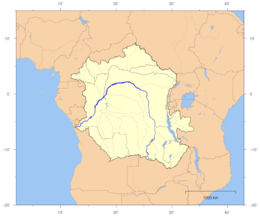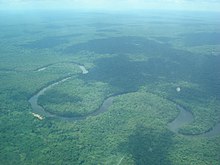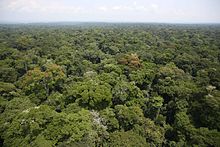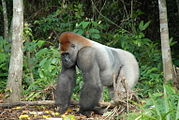Congo Basin

TheCongo Basin(French:Bassin du Congo) is thesedimentary basinof theCongo River.The Congo Basin is located inCentral Africa,in a region known as westequatorialAfrica. The Congo Basin region is sometimes known simply asthe Congo.It contains some of the largest tropical rainforests in the world and is an important source of water used in agriculture and energy generation.[1]
Therainforest in the Congo Basinis the largest rainforest in Africa and second only to theAmazon rainforestin size, with 300 million hectares compared to the 800 million hectares in the Amazon.[2]Because of its size and diversity the basin's forest is important formitigating climate changein its role as acarbon sink.[3]However,deforestationand degradation of the ecology by theimpacts of climate changemay increase stress on the forest ecosystem, in turn making the hydrology of the basin more variable.[3]A 2012 study found that thevariability in precipitation caused by climate changewill negatively affect economic activity in the basin.[1]
Eight sites of the Congo Basin are inscribed on theWorld Heritage List,five being also on thelist of World Heritage in Danger(all five located inDemocratic Republic of the Congo). Fourteen percent of the humid forest is designated as protected.[4]
Description[edit]

Congo is a traditional name for the equatorial Middle Africa that lies between theGulf of Guineaand theAfrican Great Lakes.The basin begins in the highlands of theEast African Riftsystem with input from theChambeshi,theUeleandUbangi riversin the upper reaches and theLualaba Riverdraining wetlands in the middle reaches. Because of the young age and active uplift of theEast African Riftat theheadwaters,the river's yearly sediment load is very large, but thedrainage basinoccupies large areas of low relief throughout much of its area.[5]It is delineated largely byswellsincluding the Bie, Mayumbe, Adamlia,Nil-Congo,East African, and Zambian Swells.[6]

The basin ends where the river empties into the Gulf of Guinea on the Atlantic Ocean. The basin is a total of 3.7 million square kilometers and is home to some of the largest undisturbed stands oftropical rainforeston the planet, in addition to large wetlands.
Countries wholly or partially in the Congo region:
History[edit]
The first inhabitants of the Congo Basin area were believed to bepygmies,and at that time, the dense forests and wet climate kept the population of the region low, with the prevention ofhunter-gatherersociety, whose remnants of their culture survive to the present day. EventuallyBantu peoplesmigratedthere and founded theKingdom of Kongo.
Belgium,France,andPortugallater establishedcolonial controlover the entire region by the late 19th century. The General Act of theBerlin Conferenceof 1885 gave a precise definition to the "conventional basin" of the Congo, which included the entire actual basin plus some other areas. The General Act bound its signatories to neutrality within the conventional basin, but this was not respected during theFirst World War.
TheWorld Resources Instituteestimated that 80 million people live in and around the Congo Basin.[7]

Climate[edit]
The Congo Basin is a globally important climatic region with annual rainfall of between 1500 and 2000 mm. It is one of three hotspots of deep convection (thunderstorms) in the tropics, the other two being over the Maritime continent and theAmazon.These three regions together drive theclimate circulation of the tropicsand beyond. The Congo Basin has the highestlightningstrike frequency of anywhere on the planet.[8]The high rainfall supports the second largestrainforeston Earth, which is a globally significant carbon sink[9]and an important component of the globalcarbon cycle.
Averaged across the whole basin, there are two major rainfall seasons in March to May and September to November. In both hemispheres the rainfall maximises in September to November, at above 210 mm per month. In northern hemisphere winter, rainfall is relatively low to the north of the equator (<80 mm per month). In southern hemisphere winter, rainfall is instead lower to the south of the equator (<80 mm per month). The annual rhythm of the wind systems which carry water vapour account for the rainfall seasonality. Much of the rainfall is derived from largeMesoscale convective systems.[10]The systems last over 11 hours on average and have a mean size exceeding 500 km2 in some parts of the Congo Basin.[10]

Temperatures in the Congo Basin (usually between 20 and 30 °C) are lower than in the African desert regions to the north (The Sahara) and to the south (Kalahari). The differences in temperature between the deserts and the Congo Basin is important for driving wind systems known asAfrican easterly jets,[11]which affect climate and weather in theSahelandSouthern Africa.
Future climate projections indicate that the region will get hotter in response to global climate change.[12]There is more uncertainty over how average rainfall in the region will change, with the climate models used by theIntergovernmental Panel on Climate Change(IPCC) disagreeing on core elements of the rainfall distribution in the region. While the average rainfall change is uncertain,[13]it is likely that extreme rainfall events will become more extreme owing to the increases in water vapour in the atmosphere.
Owing to the global climatic importance of the Congo Basin, it has been suggested that, along with the Amazon, severe changes in the rainfall or climate of the Congo Rainforest could act as a 'tipping point', with widespread impacts on the Earth System.[14]
Flora and fauna[edit]
The Congo forest is home to theokapi,African forest elephant,pygmy hippopotamus,bongo (antelope),chimpanzee,bonoboand theCongo peafowl.Its apex predator is theLeopard,which are larger than their savannah counterparts due to lack of competition from other large predators. The basin is home to the endangeredwestern lowland gorilla.In 2010, the United Nations Environment Programme warned that gorillas could be extinct from the greater Congo Basin in a matter of 15 years.

The Congo Basin is the largest forest in Africa. More than 10,000 plant species can be found in and around the forest.[7]The humid forests cover 1.6 million km².[4]The Congo Basin is an important source ofAfrican teak,used for building furniture and flooring. An estimated 40 million people depend on these woodlands, surviving on traditional livelihoods.
Ecology and protection[edit]
At a global level, Congo's forests act as the planet's second lung, counterpart to the rapidly dwindling Amazon. They are a huge "carbon sink",trapping carbon that could otherwise remain carbon dioxide. The Congo Basin holds roughly 8% of the world's forest-based carbon. If these woodlands are deforested, the carbon they trap will be released into the atmosphere. Predictions for future unabated deforestation estimate that by 2050 activities in theDRCwill release roughly the same amount of carbon dioxide as theUnited Kingdomhas emitted over the last 60 years. A 2013 study by British scientists showed that deforestation in the Congo Basin rainforest was slowing down.[15]In 2017, British scientists discovered thatpeatlandsin theCuvette Centrale,which cover a total of 145,500 sq km, contain 30 billion tonnes of carbon, or 20 years of U.S. fossil fuel emissions.[16][17]In 2021, the deforestation rate of the Congolese rainforest increased by 5%.[18]

The Global Forest Atlas estimated that the logging industry covers from 44 to 66 million hectares of forest.[7]A study published in 2019 inNature Sustainabilityshowed that 54,000 miles of roads for forest concessions were built between 2003 and 2018, reaching a total of 143,500 miles.[20]A moratorium on logging in the Congo forest was agreed between theWorld Bankand the Democratic Republic of the Congo in May 2002. The World Bank agreed to provide $90 million of development aid to Democratic Republic of the Congo with the provision that the government did not issue any new concessions granting logging companies rights to exploit the forest. The deal also prohibited the renewal of existing concessions.[21]
The government has written a new forestry code that requires companies to invest in local development and follow a sustainable, 25-year cycle of rotational logging. When a company is granted a concession from the central government to log in Congo, it must sign an agreement with the local chiefs and hereditary land owners, who give permission for it to extract the trees in return for development packages. In theory, the companies must pay the government nearly $18 million rent per year for these concessions, of which 40% should be returned to provincial governments for investment in social development of the local population in the logged areas.
In its current form, theKyoto Protocoldoes not reward so-called "avoided deforestation" —initiatives that protect forest from being cut down. But many climate scientists and policymakers hope that negotiations for Kyoto's successor will include such measures. If this were the case, there could be a financial incentive for protecting forests. L’Île Mbiye, an island in theLualaba RiverinKisangani,is part of a project about forest ecosystem conservation, conducted byStellenbosch University.Democratic Republic of the Congo is also looking to expand the area of forest under protection, for which it hopes to secure compensation throughemerging marketsfor forest carbon. The main Congolese environmental organization working to save the forests is anNGOcalled OCEAN, which serves as the link between international outfits likeGreenpeaceand local community groups in the concessions.
National parks[edit]
References[edit]
- ^ab"Climate Change Impacts on the Congo Basin Region".WUR.2012-09-28.Retrieved2021-09-20.
- ^The State of Forests in the Amazon basin and Southeast Asian(PDF).Brazzaville, Republic of Congo: Food and Agriculture Organization of the United Nations (FOA).ISBN978-92-5-106888-5.Retrieved14 April2012.
- ^ab"The Congo Rainforest Is Losing Ability to Absorb Carbon Dioxide. That's Bad for Climate Change".Pulitzer Center.Retrieved2021-09-20.
- ^ab"Natural World Heritage in the Congo Basin".UNESCO World Heritage Centre.Retrieved2021-05-13.
- ^Mineral deposits & Earth evolution.Geological Society. 2005.ISBN978-1-86239-182-6.
- ^Kadima, E.; Delvaux, D.; Sebagenzi, S. N.; Tack, L.; Kabeya, S. M. (2011)."Structure and geological history of the Congo Basin: an integrated interpretation of gravity, magnetic and reflection seismic data".Basin Research.23(5): 499–527.Bibcode:2011BasR...23..499K.doi:10.1111/j.1365-2117.2011.00500.x.ISSN1365-2117.S2CID53587215.
- ^abc"You can't spell Congo without NGO".Africa Reports.2021-02-28.Retrieved2021-05-13.
- ^Albrecht, R. I., S. J. Goodman, D. E. Buechler, R. J. Blakeslee, and H. J. Christian, 2016: Where Are the Lightning Hotspots on Earth?. Bull. Amer. Meteor. Soc., 97, 2051–2068,https://doi.org/10.1175/BAMS-D-14-00193.1.
- ^Dargie, Greta C., et al. "Age, extent and carbon storage of the central Congo Basin peatland complex." Nature 542.7639 (2017): 86-90.
- ^abJackson, B., S. E. Nicholson, and D. Klotter, 2009: Mesoscale Convective Systems over Western Equatorial Africa and Their Relationship to Large-Scale Circulation. Mon. Wea. Rev., 137, 1272–1294,https://doi.org/10.1175/2008MWR2525.1.
- ^Thorncroft, C.D. and Blackburn, M. (1999), Maintenance of the African easterly jet. Q.J.R. Meteorol. Soc., 125: 763-786.https://doi.org/10.1002/qj.49712555502
- ^IPCC AR6 2022
- ^Creese, A., Washington, R., & Munday, C. (2019). The plausibility of September–November Congo Basin rainfall change in coupled climate models. Journal of Geophysical Research: Atmospheres, 124, 5822– 5846.https://doi.org/10.1029/2018JD029847
- ^Garcin, Y. et al. (2022) Hydroclimatic vulnerability of peat carbon in the central Congo Basin, Nature, doi:10.1038/s41586-022-05389-3
- ^"Deforestation in Africa's Congo Basin rainforest slows".BBC News.2013-07-22.Retrieved2021-05-13.
- ^"World's largest tropical peatland found in Congo basin".the Guardian.2017-01-11.Retrieved2021-05-13.
- ^Weston, Phoebe (2020-02-28)."Plan to drain Congo peat bog for oil could release vast amount of carbon".The Guardian.Retrieved2022-04-23.
- ^"Analysis: The next Amazon? Congo Basin faces rising deforestation threat".Reuters.11 November 2022.
- ^Kinver, Mark (2019-09-12)."World 'losing battle against deforestation'".BBC News.
- ^"Logging road construction has surged in the Congo Basin since 2003".Mongabay Environmental News.2019-06-24.Retrieved2021-05-13.
- ^"The Fight to Save Congo's Forests".thenation.October 22, 2007.
External links[edit]
- Pygmies.org: African Pygmies website—first inhabitants of the Congo Basin rainforests.
- Congo drainage basin
- Congo River
- Drainage basins of Africa
- Sedimentary basins of Africa
- Regions of Africa
- Congolian forests
- Landforms of Angola
- Landforms of Cameroon
- Geography of Central Africa
- Landforms of Burundi
- Landforms of Rwanda
- Landforms of Tanzania
- Landforms of the Central African Republic
- Landforms of the Democratic Republic of the Congo
- Landforms of the Republic of the Congo
- Landforms of Zambia
- Basins of Africa


